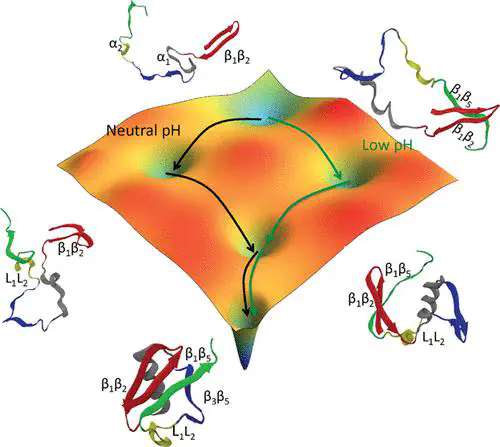 Image credit: G. Reddy
Image credit: G. Reddy
Abstract
Folding of Ubiquitin (Ub), a functionally important protein found in eukaryotic organisms, is investigated at low and neutral pH at different temperatures using simulations of the coarse-grained self-organized-polymer model with side chains (SOP-SC). The melting temperatures (Tm’s), identified with the peaks in the heat capacity curves, decrease as pH decreases, in qualitative agreement with experiments. The calculated radius of gyration, showing dramatic variations with pH, is in excellent agreement with scattering experiments. At Tm, Ub folds in a two-state manner at low and neutral pH. Clustering analysis of the conformations sampled in equilibrium folding trajectories at Tm, with multiple transitions between the folded and unfolded states, shows a network of metastable states connecting the native and unfolded states. At low and neutral pH, Ub folds with high probability through a preferred set of conformations resulting in a pH-dependent dominant folding pathway. Folding kinetics reveal that Ub assembly at low pH occurs by multiple pathways involving a combination of nucleation-collapse and diffusion collision mechanism. The mechanism by which Ub folds is dictated by the stability of the key secondary structural elements responsible for establishing long-range contacts and collapse of Ub. Nucleation collapse mechanism holds if the stability of these elements are marginal, as would be the case at elevated temperatures. If the lifetimes associated with these structured microdomains are on the order of hundreds of microseconds, then Ub folding follows the diffusion–collision mechanism with intermediates, many of which coincide with those found in equilibrium. Folding at neutral pH is a sequential process with a populated intermediate resembling that sampled at equilibrium. The transition state structures, obtained using a Pfold analysis, are homogeneous and globular with most of the secondary and tertiary structures being native-like. Many of our findings for both the thermodynamics and kinetics of folding are not only in agreement with experiments but also provide missing details not resolvable in standard experiments. The key prediction that folding mechanism varies dramatically with pH is amenable to experimental tests.